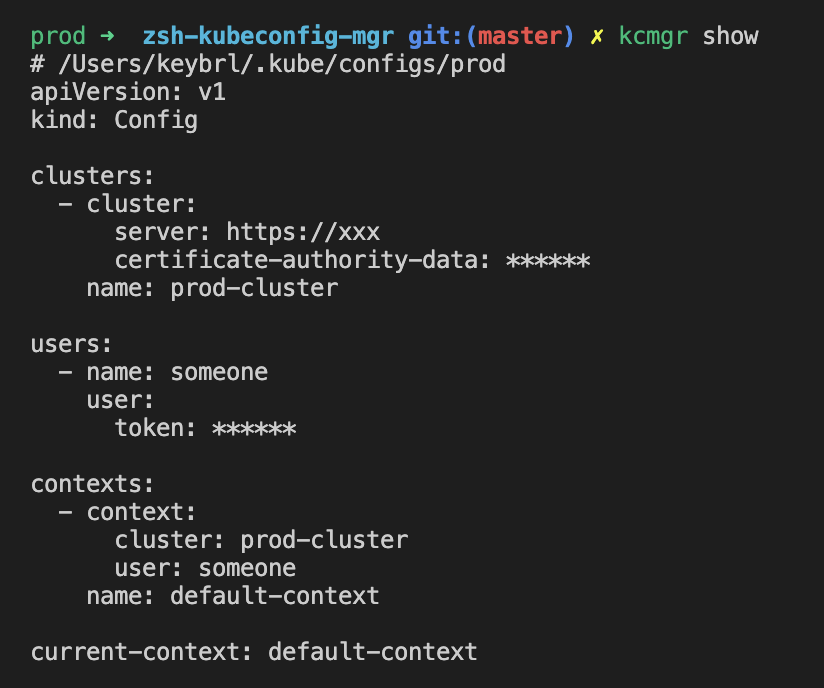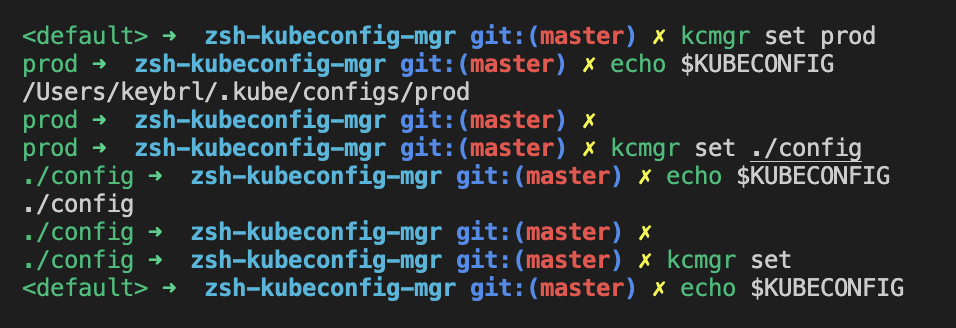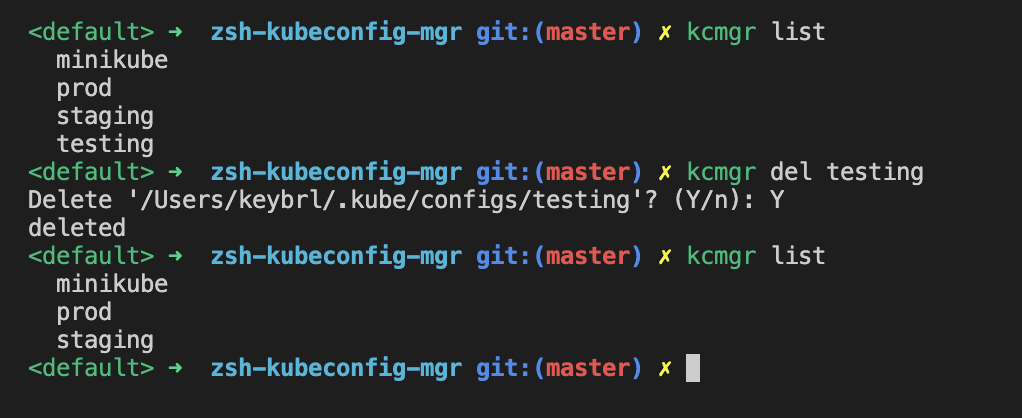English | 简体中文
This project is a plugin for Zsh and oh-my-zsh, Designed to make managing and using multiple kubeconfig files easier.
In some cases, it may be necessary to operate multiple different Kubernetes clusters, each with different credentials. And it might not be convenient to combine them into one kubeconfig file for various reasons. Therefore, when operating different clusters, you must frequently set the environment variable $KUBECONFIG to different values, or use the parameter --kubeconfig /path/to/config ... to specify different kubeconfig files when executing kubectl, these operations are very tedious and error-prone.
This project will provide an idea to solve these problems.
Oh-my-zsh:
If you have installed oh-my-zsh, then:
- Clone this repository in oh-my-zsh's plugins directory:
git clone https://github.com/yhlooo/zsh-kubeconfig-mgr.git ${ZSH_CUSTOM:-~/.oh-my-zsh/custom}/plugins/zsh-kubeconfig-mgr - Activate the plugin in
~/.zshrc:plugins=( [plugins...] zsh-kubeconfig-mgr)
- Restart zsh (such as by opening a new instance of your terminal emulator).
Zsh:
If you don't have oh-my-zsh installed, you can simply clone this repository and source the script:
git clone https://github.com/keybrl/zsh-kubeconfig-mgr.git
source ./zsh-kubeconfig-mgr/zsh-kubeconfig-mgr.zsh
echo "source ${(q-)PWD}/zsh-kubeconfig-mgr/zsh-kubeconfig-mgr.zsh" >> ${ZDOTDIR:-$HOME}/.zshrcThe plugin provides a command line prompt which can be added to the variable PROMPT or RPROMPT as you need
Simply add something like the following to the end of ~/.zshrc :
PROMPT='$(kubeconfig_prompt_info) '$PROMPTThe function kubeconfig_prompt_info will print the kubeconfig specified by the current environment variable $KUBECONFIG . Its value has the following situations:
<default>means$KUBECONFIGis empty, the active kubeconfig is~/.kube/configconfigmeans~/.kube/configs/config./path/to/configindicates the relative path to kubeconfig~/path/to/configindicates the path of the kubeconfig relative to$HOME/path/to/configindicates the absolute path of kubeconfig
The printed color indicates whether the corresponding kubeconfig exists or not:
- Green: Exist
- Red: Not exist or not a file
Example:
Add the following to the end of ~/.zshrc :
PROMPT='$(kubeconfig_prompt_info) '$PROMPTEffect:
kcmgr ls , kcmgr list or lkc (list kubeconfig)
list all filenames in the directory ~/.kube/configs/
kcmgr show [config] or rkc [config] (read kubeconfig)
kcmgr showShow the content of the currently effective kubeconfigkcmgr show <config>Show the content of the specified kubeconfig
kcmgr set [config] or skc [config] (set kubeconfig)
kcmgr setequivalent tounset KUBECONFIGkcmgr set <config>set$KUBECONFIGto the specified kubeconfig
kcmgr delete [config] , kcmgr del [config] or dkc [config] (delete kubeconfig)
kcmgr deleteDelete the currently effective kubeconfigkcmgr delete <config>Delete the specified kubeconfig
kcmgr edit [config] or ekc [config] (edit kubeconfig)
kcmgr editEdit the currently effective kubeconfigkcmgr edit <config>Edit the specified kubeconfig
Prefer vim , or vi if vim not found. If kubeconfig does not exist it will be created.






